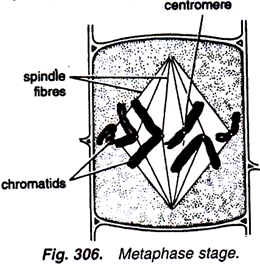ADVERTISEMENTS:
In this article we will discuss about the four phases of mitosis with suitable diagram and also learn about its significance.
The mitosis is a part of somatic cell division which includes the division of the nucleus (called mitosis or karyokinesis) and the division of the cytoplasm (called cytokinesis). Strasburger (1875), a German botanist, was the first to work out the details of mitosis. Mitosis can be studied best in the root tip and shoot tip of several plants. But the most favourable material is the apices of onion roots.
In mitosis, the metabolic nucleus passes through a complicated system of changes in the form of four different stages, viz., prophase, metaphase, anaphase and telophase. Some important aspects of all these stages are discussed below.
ADVERTISEMENTS:
i. Prophase (Gr. pro, before):
1. It is the first and the longest phase in the mitotic cell division.
2. Chromosomes become visible in the nucleus as short, thick, helically coiled threads (Fig. 305A).
ADVERTISEMENTS:
3. Each chromosome splits into two chromatids (Fig. 305B, C) joined at the centromere.
4. Nuclear membrane starts dissolving.
5. Nucleolus also starts dissolving and disappearing.
6. Prophase changes into next stage called metaphase.
4. Chromosomes become shorter and thicker.
5. Chromosomes arrange themselves in the centre or on the equator of spindle.
6. At the end of metaphase, two chromatids of each chromosome also start separating.
ii. Metaphase (Gr. meta, between):
1. Nuclear membrane disintegrates and disappears completely (Fig. 306).
ADVERTISEMENTS:
2. Nucleolus disintegrates and disappears completely.
3. Spindle fibres start appearing and these fibres get attached to chromosomes at centromeres.
4. Chromosomes become shorter and thicker.
ADVERTISEMENTS:
5. Chromosomes arrange themselves in the centre or on the equator of spindle.
6. At the end of metaphase, two chromatids of each chromosome also start separating.
7. Metaphase changes into the next stage called anaphase.
iii. Anaphase (Gr. ana, back):
1. Chromatids separate from each other at centromere and called daughter chromosomes (Fig. 307).
2. Daughter chromosomes move to the opposite poles of the spindle.
3. Daughter chromosomes appear ‘V’, ‘U’ or J-shaped during their movement towards poles.
4. Anaphase changes into the next stage called telophase.
ADVERTISEMENTS:
iv. Telophase (Gr. telo, end):
1. Daughter chromosomes are now at the end of the spindle, i.e., present on two opposite poles (Fig. 308A).
2. Nuclear membrane reforms around each group of daughter chromosomes (Fig. 308B).
3. Nucleolus reforms (Fig. 308C).
4. Two nuclei are thus organised, one at each pole of the parent cell.
ADVERTISEMENTS:
5. Chromosomes begin to loose their compact structure.
6. Spindle fibres disappear gradually.
7. Thus formed two daughter nuclei are exactly similar to the parent nucleus.
Significance of Mitosis:
1. Mitosis results in the formation of two daughter cells identical with that of the parental cell.
2. By this process, DNA, the main component of chromosomes, is distributed equally among the two newly formed nuclei.
ADVERTISEMENTS:
3. Both the daughter cells formed after mitosis are identical and have the same genetic constitution, qualitatively as well as quantitatively, as the parent cell.
4. The number of chromosomes remains the same from one generation to another generation.
5. Resulted daughter cells have the same characters as were present in the parent cell.
6. The characters of the plants grown by vegetative reproduction may be preserved for a long period.




